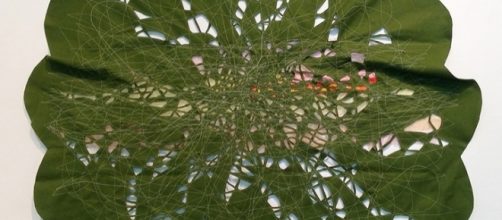Lisa Cooperman is an artist from California whose work in textiles has been exhibited across the country. Cooperman is inspired by found materials, nature, and the Central Valley in which she resides. She is also the university curator at the University of the Pacific in Stockton and currently has artwork on display in New York's A.I.R. Gallery. Cooperman recently discussed her life as a creative visual artist and more via an exclusive interview.
Fabric, materials, and art
Meagan Meehan (MM): What initially inspired you to create art and why did you gravitate towards textiles?
Lisa Cooperman (LC): I've always made stuff - to amuse myself, to wear, for theater projects. Textiles were one of the first materials I explored, and set of techniques I learned; I have come back to them after working in more traditional media like metal.
MM: What things most inspire your artistic drive?
LC: I tend to respond to the deep stories about places I'm living. Material culture - the everyday things people produce or use that are unique to that space - is a connection to those stories. I also hate waste and am always considering how the material can be repurposed. There is such interesting stuff out there.
MM: What are the rewards and challenges of making modern art out of fabrics and textiles?
LC: The reward is that the material is embedded with meaning before it even changes through the creative process. The fun is subverting or reinventing those meanings, plus color, texture, and fabric availability, as well as a place for the studio cats to nap. Textile art seems to be 'on trend' right now, and there is much fantastic work being made with textiles and textile techniques. It is a medium traditionally associated with 'women's art' and has historically been disregarded and considered 'crafty.' I consider this all the more reason to stake out its richness and flexibility.
MM: Do you have any favorite pieces of art and are you planning any to create any interesting future series?
LC: I adore the work of Ghanaian artist El Anatsui and hope to bump up the scale of art I'm making now.
I hope it’s interesting!
Exhibitions, galleries, and aspirations
MM: Can you tell us about your present show at A.I.R. Gallery, such as what inspired the artwork displayed within it?
LC: My current show, Baize, was inspired by fabric. Baize is a traditional heavy wool used on doors to muffle the sounds of downstairs domestic activity and separate it from the upstairs. Eventually, it was used on furniture and gaming tables. My show is built from a discarded stash of wool tablecloths used by the local chapter of the Ladies Auxiliary of California Pioneers. I used to work at the museum where they held their annual card parties - the same museum that this pioneer group helped found in 1931 in Stockton, California.
The wall hung sculpture in the exhibition is a sort of imaginary conversation with the landscape itself and the people who typically don't have their stories told, or have museums dedicated to their achievements. I see the work as an alternative way to honor labor and provide some counter mythos.
MM: How did you get your art represented by galleries, how did you get involved with A.I.R. Gallery, and where else has your art been exhibited?
LC: I was juried into a group exhibition at A.I.R. by Anne Ellegood who was then at the New Museum and the gallery invited me to join after that. I've participated in some group shows with the A.I.R. National Members and had my first solo show with them in 2010.
It has been a tremendous source of community for me, living away from a major art center as I do. I show in group exhibitions around the country - recently The Feminist Sex Shoppe at On the Ground Floor in Los Angeles, Flesh Anew at Conrad Wilde in Tucson, Old Enough to Know Better at the Women's Caucus for Art in Philadelphia.
MM: To date, what do you regard as being the highlight of your artistic career?
LC: Nothing beats New York - and holding hands with Faith Ringgold one night at A.I.R.!
MM: You also work as a curator so how do you think that role affects your work, if at all?
LC: Working as a curator takes care of my preference to have things 'just so' and allows me to see the bigger picture; it indulges my fondness for research and gives me an opportunity to act as a creative facilitator.
Both activities satisfy my interest in making unusual connections between material and ideas, both require strenuous editing and resisting the urge to explain too much. But making art is very internal; the only thing I must wrestle is the material and myself (plus the critical weight of art history...) It certainly makes me sympathetic toward everyone working to get something meaningful up on the walls in time. Regarding my aspirations, right now I'm learning all about collection management but I still have a stack of green felt tablecloths so, who knows!


